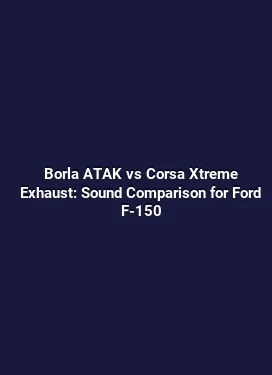Race Cat vs Test Pipe Performance Gains: Legal Considerations
Understanding the Core Difference: Race Cat and Test Pipe in the Exhaust System

The exhaust system plays a pivotal role in how an engine breathes, and the choice between a race catalytic converter (race cat) and a test pipe is one of the most debated topics among enthusiasts seeking gainful performance. A race cat is a high-flow catalytic converter engineered to preserve catalytic activity while reducing flow restriction compared to a stock unit. In contrast, a test pipe omits the catalytic substrate altogether, creating a direct path for exhaust gases from the manifold to the rear of the vehicle. This fundamental distinction translates into measurable differences in backpressure, exhaust gas velocity, and ultimately, engine response and thrust.
From a flow perspective, a race cat maintains some level of catalytic surface area to partially meet emission standards, albeit in a design optimized for lower pressure drop. A test pipe, by removing the catalyst, typically reduces backpressure more aggressively, allowing exhaust pulses to travel with less impedance. The resulting change can manifest as quicker turbo spool in forced-induction applications, a more aggressive throttle response, and a potential uptick in peak power. However, this raw performance comes with caveats that extend beyond purely mechanical calculations and into the realm of regulations and practical usability on public roads.
Performance Gains: What, Why, and How They Show Up
Performance gains from switching to a race cat or a test pipe come from several intertwined factors: flow efficiency, exhaust gas temperatures, and the interaction with the engine’s control strategies. When gases exit a cylinder, the speed and volume of the flow influence scavenging, particularly at mid to high RPM ranges. A race cat reduces restriction while maintaining some catalytic functionality, which helps balance flow with emissions compliance. A test pipe eliminates the catalytic barrier entirely, often delivering the most noticeable flow improvement but at the potential cost of higher exhaust gas temperatures and louder operation.
Practical observations from track and dyno testing commonly show that the race cat yields a smoother, more linear power curve with modest improvements in mid-range torque. In contrast, a test pipe frequently delivers a higher peak horsepower figure and a sharper throttle response, especially in turbocharged setups. It’s important to contextualize these gains within the rest of the exhaust system, intake, and fuel delivery, because the engine’s evolving torque curve is shaped by the entire ecosystem rather than a single component. For enthusiasts aiming for predictable performance, the trade-off choice often centers on legal viability and daily drivability versus raw straight-line speed on the track.
Considerations for Naturally Aspirated Engines

In naturally aspirated applications, improvements from a race cat or test pipe may be less dramatic than in forced-induction setups, but the principles remain: improved exhaust flow can lower pumping losses and allow the engine to operate closer to its volumetric efficiency sweet spot. A race cat’s balance between flow and emissions can deliver meaningful gains without pushing the vehicle into compliance gray areas, while a test pipe may yield a more significant echo of performance gains in optimized NA builds with refined intake and exhaust tuning.
Takeaways for Forced-Induction Systems
Turbocharged and supercharged engines react distinctly to exhaust tweaks. A race cat can help preserve turbocharging efficiency by maintaining catalytic integrity at a higher flow level, while a test pipe might unlock more aggressive boost behavior and faster spool. The exact outcomes depend on turbine sizing, intercooling, fuel mapping, and the exhaust manifold geometry. When considering these upgrades, the goal is to harmonize exhaust energy release with the compressor’s efficiency window to extract practical gains across usable RPM ranges.
Legal Landscape: Regulations, Compliance, and Regional Nuances
Legal considerations around exhaust components are not universal and vary by jurisdiction, vehicle type, and application. In several regions, catalytic converters are required to meet emissions standards for on-road operation. Removing or bypassing a catalyst or installing a direct pipe can constitute illegal tampering in some markets, leading to penalties, failed inspections, or warranty concerns. Conversely, many jurisdictions allow dedicated off-road or track-use installations that are not intended for public roads, yet may still be subject to noise and emissions constraints if registered for street use.
In North America, some states enforce strict CARB (California Air Resources Board) compliance for on-road vehicles. A race cat is typically designed to meet heightened efficiency metrics relative to stock while still offering reduced backpressure. A test pipe, however, often falls into a category that could be considered non-compliant for street use, especially when the vehicle is expected to pass a conventional emissions test. In Europe, homologation and type-approval frameworks influence what can be legally used on public roads. Local municipalities may also impose noise restrictions that impact certain exhaust configurations regardless of catalytic status.
Striking the Balance: Street vs Track Scenarios
For street-driven vehicles, the priority is often reliability, warranty protection, and compliance with local laws. A race cat commonly serves as a middle ground, delivering performance improvements without triggering significant regulatory risk, provided it remains within the allowed emissions framework. Track-focused builds or off-road applications may benefit more visibly from a test pipe, where regulatory hurdles are less restrictive or contextually inapplicable. In any case, owners should verify applicable requirements before installation and understand the legal implications in their specific area.
Documentation, Certification, and Responsible Ownership
Car owners seeking performance upgrades should keep thorough documentation of all modifications, including part numbers, installation dates, and any professional tuning performed. If a vehicle undergoes emissions testing or a regulatory inspection, having ready documentation can help demonstrate intent and compliance status. Responsible ownership also includes recognizing warranty implications: aftermarket exhaust components can influence coverage, and certain manufacturers may require notice of changes to exhaust configuration when evaluating claims.
Practical Guide: Selecting Between Race Cat and Test Pipe
Choosing between a race cat and a test pipe hinges on several practical factors: intended use, local regulations, acoustic tolerance, and the overall build strategy. Begin with a clear objective: is the goal to maximize straight-line performance on a track, improve daily drivability with a balance of power and emissions, or pursue a purist approach focused on weight reduction and minimal backpressure? Once the objective is defined, the following considerations come into play.
Assessing Vehicle Specifics and Tuning Readiness
Engine architecture, turbocharger or naturally aspirated configuration, and the current exhaust layout determine how a modification will behave. A high-flow race cat should be paired with appropriate fueling and ignition adjustments to avoid unintended knock or rich conditions. A test pipe may necessitate recalibration of turbo maps, boost targets, or cam timing to maintain safe operation and to maximize the dormant potential within the exhaust’s improved flow path.
Acoustics, Thermal Management, and Longevity
Exhaust changes influence noise levels and thermal profiles under load. A louder configuration can affect cabin comfort, neighbor-friendly operation, and potential noise enforcement actions. Thermal considerations include the increased exhaust gas temperatures that can arise with reduced backpressure, which in turn can affect turbo efficiency, exhaust manifold heat, and downstream components. Ensuring proper heat shielding, hangers, and fitment prevents rattles and vibrations that often accompany aggressive exhaust setups.
Installation Realities: Fitment, Fitment, and Verification
Proper fitment is essential for long-term reliability. A race cat or test pipe must align precisely with flange spacing, gasket compatibility, and downstream piping. It’s advisable to prototype with temporary hardware where possible and to rely on certified installation services when available. After installation, performing a leak check and a careful test drive under varied loads helps confirm that the system behaves consistently across RPM bands and driving conditions.
Performance Metrics: What to Measure and How to Interpret
To quantify gains from any exhaust modification, several measurement approaches provide valuable insight. Dynamometer tests reveal horsepower and torque deltas across the RPM spectrum, while data logging during street and track sessions can illustrate throttle response, boost dynamics, and transient behavior. For turbocharged setups, observing spike pressures and compressor maps can indicate whether the chosen path optimizes energy recovery and reduces pump losses. Real-world feedback, such as reduced lag or crisper mid-range acceleration, complements numerical results and informs future tuning decisions.
Interpreting Dyno and Real-World Data
Expect some variability due to ambient conditions, drivetrain losses, and minor installation differences. A race cat may show a smooth but incremental improvement, while a test pipe could yield a more pronounced peak gain with a narrower usable window. The key is to correlate the numbers with driving feel: smoother power delivery, reduced throttle bottlenecks, and a more eager engine response during revving cycles are practical signs of a successful modification.
Reliability and Maintenance Considerations
With any exhaust upgrade, staying alert to component wear, gaskets, and potential heat-related stress on nearby parts is essential. A race cat, having catalytic material, may exhibit different aging characteristics compared with a pure pipe, though both options should be inspected for cracks, leaks, and mounting integrity on a regular maintenance cycle. Regular inspection helps prevent small issues from escalating into more costly repairs or performance inconsistencies.
Ethical and Environmental Context: Emissions and Public Roadways
Despite the appeal of performance gains, environmental responsibilities remain a core consideration. Catalytic converters play a crucial role in reducing pollutants, and any modification that diminishes catalytic activity can impact air quality and compliance with vehicle emission standards. A practical approach is to pursue performance enhancements that respect regulatory frameworks, such as choosing high-flow catalysts designed to maintain substantial conversion efficiency or reserving non-compliant configurations for closed-course environments where public-road emission constraints do not apply.
Future-Proofing Your Setup
As emissions regimes evolve and enforcement becomes more sophisticated, building a system with modularity in mind can provide flexibility. Selecting components that allow for easy reversion to stock or to compliant configurations during inspections can reduce risk. This adaptability is especially valuable for enthusiasts who rotate vehicles seasonally or participate in sanctioned events with varying rules.
Long-Term Considerations: Warranty, Resale, and Community Wisdom
Warranty implications are a practical concern for many owners. Some manufacturers request modification disclosure as a condition of warranty eligibility, while others reserve the right to deny claims if aftermarket exhaust changes are deemed to have caused a failure. When evaluating resale value, a well-documented modification history, paired with appropriate quality parts and professional installation, can enhance perceived value and confidence for prospective buyers.
Engaging with the broader automotive community can yield valuable perspectives. Real-world experiences, including installation tips, common fitment challenges, and tuning strategies, can complement the technical information and help assemble a robust, informed plan for pursuing a race cat or test pipe upgrade responsibly.






